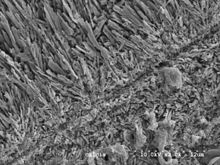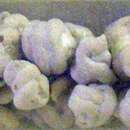Glomerula: Brief Summary
provided by wikipedia EN

Glomerula piloseta, longitudinal section of the tube
Glomerula is a genus of polychaete worm in the family Sabellidae. It differs from all other Sabellidae in having a calcareous tube and spinose setae. Only one living species, G. piloseta, is known from Lizard Island, Great Barrier Reef, Australia. The oldest fossils of Glomerula are known from the Early Jurassic and their tube microstructure has remained unchanged since then.
- license
- cc-by-sa-3.0
- copyright
- Wikipedia authors and editors
Status
provided by World Register of Marine Species
ten Hove & Kupriyanova (2009) state that "According to Ippolitov (2007: 260), the name Glomerula Nielsen, 1931 should be “unavailable according to ICZN 13.3)”. No further explanation is given by Ippolitov. If he is referring to Article 13 (iii), the full text of that is: “Article 13. Names published after 1930.- (a) Names in general.- In addition to satisfying the provisions of Article 11, a name published after 1930 must be either . . . (iii) proposed expressly as a replacement fro a pre-existing available name”. Nielsen (1931: 85) defines the genus Glomerula in a key, and (p. 88) attributes a single species (Serpulites gordialis von Schlotheim, 1820) to his genus. Nielsen, who did not give any explanation for his action at all, either replaced the generic name Serpulites, a name explicitly unavailable according to “Article 20. Genus-group names ending in –ites . . . given to fossils.”, or he simply placed the species gordialis in a new genus. Both ways we do not see conflict with the Code, certainly not with 13 (iii), and in our opinion the name Glomerula is available, though not being a serpulid."
- license
- cc-by-4.0
- copyright
- WoRMS Editorial Board


 Glomerula piloseta, longitudinal section of the tube
Glomerula piloseta, longitudinal section of the tube